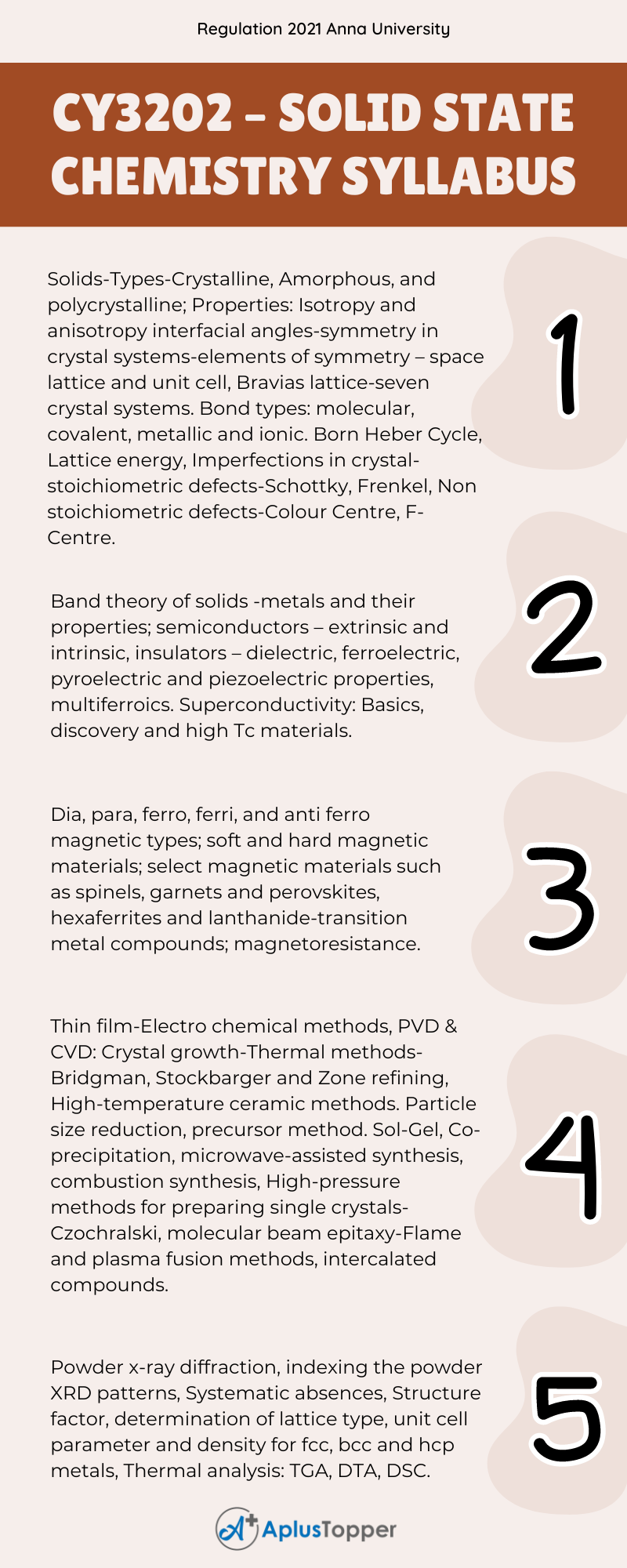Solid state chemistry is the subject of semester II of Anna University B.E Material Science And Engineering Syllabus. In this article, we are glad to provide the syllabus of solid state chemistry part of Semester II Subjects in the first-year course.
We intend to provide the subject code CY3202 – Solid state chemistry syllabus based on regulation 2021 by Anna University. You can get an idea of the topics in the syllabus of solid-state chemistry. We hope that the absolute idea on the syllabus will assist the students in avoiding confusion of revision according to weightage. We also include required textbooks and references. If you require anything regarding the syllabus you can comment in the below section. Hope you like this information. Don’t forget to share.
If you want to know more about the syllabus of B.E. Material Science And Engineering connected to an affiliated institution’s four-year undergraduate degree program. We provide you with a detailed Year-wise, semester-wise, and Subject-wise syllabus in the following link B.E. Material Science And Engineering Syllabus Regulation 2021 Anna University.
Aim Of Objectives:
- To understand and apply the basics of principles of solid state chemistry.
- To identify and apply the concepts involved in the synthesis, structure, and physical properties of crystalline inorganic solids.
- To apply various techniques for the preparation of different types of solids.
- To understand the principles of solid characterization techniques.
CY3202 – Solid State Chemistry Syllabus
Unit – I: Crystal Structure
Solids-Types-Crystalline, Amorphous, and polycrystalline; Properties: Isotropy and anisotropy interfacial angles-symmetry in crystal systems-elements of symmetry – space lattice and unit cell, Bravias lattice-seven crystal systems. Bond types: molecular, covalent, metallic and ionic. Born Heber Cycle, Lattice energy, Imperfections in crystal-stoichiometric defects-Schottky, Frenkel, Non stoichiometric defects-Colour Centre, F-Centre.
Unit – II: Electrical Properties
Band theory of solids -metals and their properties; semiconductors – extrinsic and intrinsic, insulators – dielectric, ferroelectric, pyroelectric and piezoelectric properties, multiferroics. Superconductivity: Basics, discovery and high Tc materials.
Unit – III: Magnetic Properties
Dia, para, ferro, ferri, and anti ferro magnetic types; soft and hard magnetic materials; select magnetic materials such as spinels, garnets and perovskites, hexaferrites and lanthanide-transition metal compounds; magnetoresistance.

Unit – IV: Synthetic Methods
Thin film-Electro chemical methods, PVD & CVD: Crystal growth-Thermal methods-Bridgman, Stockbarger and Zone refining, High-temperature ceramic methods. Particle size reduction, precursor method. Sol-Gel, Co-precipitation, microwave-assisted synthesis, combustion synthesis, High-pressure methods for preparing single crystals-Czochralski, molecular beam epitaxy-Flame and plasma fusion methods, intercalated compounds.
Unit – V: Solid Characterization Techniques
Powder x-ray diffraction, indexing the powder XRD patterns, Systematic absences, Structure factor, determination of lattice type, unit cell parameter and density for fcc, bcc and hcp metals, Thermal analysis: TGA, DTA, DSC.
Text Books:
- West, Antony R. Solid state chemistry, An introduction”. Ist Edn.John Wiley & Sons, Singapore 2003.
- E. Smart and E. A. Moore, Solid State Chemistry – An Introduction, 4th Edition, CRC Press, 2012.
References:
- V. Keer, Principles of the Solid State, 2nd Edition, New Age International, 2017.
- Sandra E. Dann, “Reactions and Characterization of solids”. IstEdn.The Royal Society of Chemistry, Cambridge, 2000.
- Weller, T. Overton, J. Rourke, and F. Armstrong, Inorganic Chemistry, 6th Edition, Oxford University Press, 2014. (South Asia Edition 2015)
Related Posts Of Semester – II:
- HS3252 – Professional English – II
- MA3251 – Statistics and Numerical Methods
- BE3251 – Basic Electrical and Electronics Engineering
- GE3251 – Engineering Graphics
- GE3252 – தமிரு் ததொழி்நு்பமு் /Tamils
Must Read:
